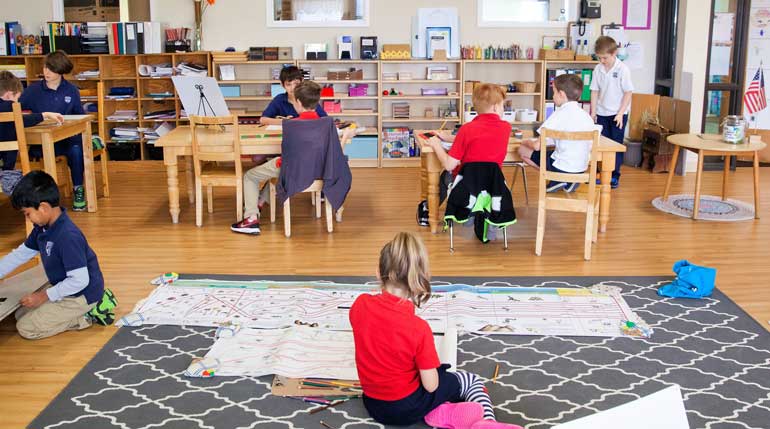
One Size Doesn’t Fit All
The fundamental difference between Montessori and traditional educational methods can be viewed here: Montessori vs. Mainstream Education. As well, this video gives a helpful overview of the difference between a (properly accredited) Montessori school and other methods, both traditional and progressive..
The Difference in Montessori vs. Traditional Preschool
The difference between Montessori and non-Montessori preschool curricula becomes strikingly clear when the respective classroom environments are compared.
The traditional approach exemplified in schools and preschools has a teacher impart a theme or concept to a group, with everyone learning the same thing simultaneously. Following the revolutionary approach of Montessori into our communities, some traditional preschools began adopting various Montessori-like concepts, but without a firm grounding in the methodology, thus prolonging the child’s development.
Alternately, the Montessori Method begins by asserting that “one size doesn’t fit all.” Each child is uniquely disposed to learn at different rates and through emphasis on different senses. Thus, Montessori customizes its approach to the singular needs of each child and to their corresponding stages of development.
In an AMI-accredited Montessori school, learning is a synthesis of the child’s own exploration and the teacher’s guidance and input. The Montessori Classroom uses specialized materials which progress in complexity as the child advances. Once a lesson is taught, the child is encouraged to freely explore the materials from various angles. Through such handling of the materials, the child comprehends the core functions of each lesson and therein the abstract concepts are eventually absorbed. The materials are designed for self-education, self-correction and boundless creativity.
Defining "Happiness"
It is every parent’s wish for their child to know happiness and success. Although a relative term, the question of how one measures a child’s happiness is an intriguing one. Most parents defer to their child’s self-assessment of happiness. As a rule, happiness for a child stems primarily from instant gratification.
Joy-filled learning and discovery lie at the heart of Montessori education. While comprehensive Montessori programs, such as those offered at Cedar Park Montessori School and Sapientia Montessori School, are not lacking in the comforts, infrastructure, play-areas and delights of traditional schools, the typical Montessori school is not a Pandora’s Box of distractions. Overly stimulating wall posters, colors and paraphernalia do not factor into the ambiance of a Montessori environment.
We recognize that, while temporarily enjoyable, such hyper-stimulation is not conducive to the learning process and the peaceful, balanced environment that’s so essential to the child’s overall development and well-being.
Regrettably, there is a general lack of awareness that a child’s foremost period of concept-absorption is between the ages of 0 and 5 (the first stage of development) — particularly the first three years. Given that the core foundation of what will become the child’s “worldview” is largely established during this formative period of his/her life, how we want our children to spend those first years is of crucial importance. Is it transient “play” or an enduring joy more geared toward true happiness?
A balanced and peaceful environment constitutes the vision of Montessori. We envision our children thriving now and for the rest of their lives. The Montessori environment is designed to foster the child’s ongoing joy of learning and their natural absorption of knowledge and understanding. Consequently, the fruits of the independence, skills and creativity — and the manifold social interactions they have with their peers — are the freedom to explore and discover who they are in relation to their environment.
Today, parents face a difficult choice. What kind of “happiness” do we seek for our children? Something fleeting — or true life enrichment?

